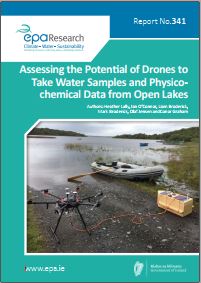Research 341: Assessing the Potential of Drones to Take Water Samples and Physico-chemical Data from Open Lakes
Authors: Heather Lally, Ian O’Connor, Liam Broderick, Mark Broderick, Olaf Jensen and Conor Graham
Summary: Water sampling remains a key component in the monitoring and assessment of aquatic environments. Sampling requiring the use of a boat can lead to issues around accessibility, particularly at remote lakes where there may be a lack of a slipway. This research has successfully demonstrated that water chemistry data collected using drone water sampling methods are not statistically different from those produced by boat sampling.

Water quality :: Environmental Protection Agency, Ireland
https://www.epa.ie/media/epa-2020/publications/research/Thumbnail_341.jpg